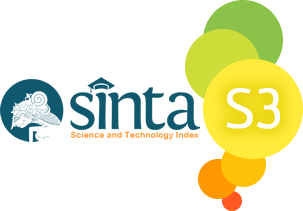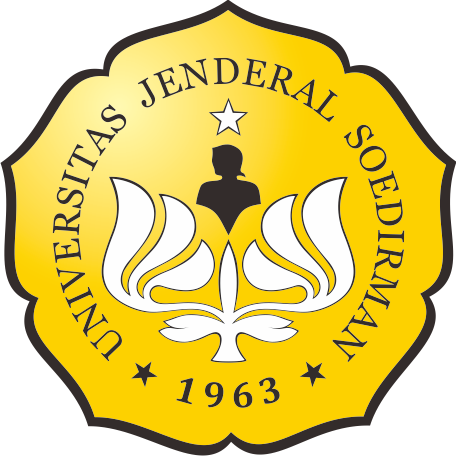HUBUNGAN ANTARA KANDUNGAN SILIKA DENGAN KELIMPAHAN DIATOM BENTHIK DI SEPANJANG SUNGAI PELUS KABUPATEN BANYUMAS
Abstract
Silica is an element that is useful to the organism especially Diatoms (Chrysophyta: Bacillariophyceae). The sources of Silica in waters derive from weathering rock-containing silica. Diatoms are a phytoplankton that able to live as a phytobenthos distributed globally in all types of waters. The purpose of this study was to determine; the silica content, the abundance of diatoms, and the relationship between the content of silica and the abundance of diatoms in the Pelus River Banyumas. This research was conducted as a survey and samples were collected using composite sampling technique at 5 stations. Samples were collected three times with 2 weeks intervals. Two main parameters (diatoms abundance and silica content) and ten supporting parameters (temperature, current velocity, pH, DO, BOD, COD, TSS, TDS, nitrate, and ortofosfat of waters) were measured. Data of analysis calculated in this study including regression correlation analysis to determine the relationship of the silica content and the abundance of diatoms. The silica concentration in the Pelus River waters varies between 112.48-175.00 mg.l-1 with an average of 146 mg.l-1. The total abundance of benthic diatoms was 44,442 ind.cm-2. The highest diatoms abundance was at station II (11,128 ind.cm-2), the lowest was at Station IV (6,828 ind.cm-2). The relationship between silica contained in the waters and abundance of diatoms indicated by the value of R2 (coefficient of determination) by 0.38 or 38%. The abundance of Diatoms are affected 62% by the available silica in the environment, and the rest 38% e rest are determined by other factors.
Keywords
Full Text:
PDFReferences
Alaerts GA, Santika SS. 1987. Metoda Penelitian Air. Surabaya: Usaha Nasional.
APHA (American Public Health Association). 1985. Standard Method for the Examination of Water and Waste Water 12th Edition. Washington DC : APHA–AWWA–WPCF.
APHA (American Public Health Association). 1989. Standard Method for the Examination of Water and Waste Water 12th Edition. , Washington DC: APHA–AWWA–WPCF.
APHA. (American Public Health Association). 1992. Standard Method for the Examination of Water and Waste Water 12th Edition. Washington DC: APHA–AWWA–WPCF.
Aprisanti R, Mulyadi A, Siregar SH. 2013. Struktur Komunitas Diatom Epilitik Perairan Sungai Senapelan Dan Sungai Sail, Kota Pekanbaru. Jurnal lingkungan. ISSN 1978–5283.
Badan Standarisasi Nasional. 1991a. Air dan Limbah: SNI 06–2503–1991. Jakarta.
Badan Standarisasi Nasional. 2005b. Air dan Limbah: SNI 06–2503–2005. Jakarta.
Bellinger EG, Sigee DC. 2010. Freshwater algae: Identification and us as bioindicators 1sted. Wiley–Blackwell: Oxford. https://doi.org/10.1002/9780470689554
Boyd CE. 1988. Water Quality in Warmwater Fish Pond. Forth Printing. Alabama USA: Agricultural Experiment Station Auburn University.
Davis. 1955. The Marine and Fresh–Water Plankton. Chicago: Michigan State Universitas Press.
Doods WE. 2002. Freshwater Ecology : Concepts and Environmental Applications. San Diego: Academic Press.
Effendi H. 2003. Telaah Kualitas Air Bagi Pengelolaan Sumber Daya dan Lingkungan Perairan. Yogyakarta: Kanisius.
Forsstrom L. 2006. Phytoplankton Ecology of Subarctic Lakes in Finnish Lapland. Helsinki: Departement of Biological and Environmental Sciences Division of Aquatic Sciences University of Helsinki.
Harding WR, Archibaid CGM, Taylor JC. 2005. The Relevance of Diatoms for Water Quality Assessment in South Africa: A Position Paper. http://www.wrc.org.za
Haslam SM. 1995. Biological Indicators of Freshwater Pollution and Enviromental Management. London: Elsevier Applied Science Publisher.
Lee RE. 2008. Phycology 4th Edition. New York: Cambrigde University Press xii + 547 hlm.
Odum EP. 1971. Fundamental Of Ecology 3rd Edition. Philadelphia: W. B. Saunders Company.
Pescod MB. 1973. Investigation of Rational Effluent and Stream Standard for Tropical Countries. Bangkok: Enironmental Engineering Division Asian Institute Technology.
Sachlan M. 1982. Planktonologi. Semarang: Fakultas Peternakan dan Perikanan Universitas Diponogoro.
Subarijanti HU. 2003. Faktor Lingkungan yang Mempengaruhi Pertumbuhan Plankton. Jakarta: Kumpulan Jurnal Perikanan. LON. URL:http://digilib.brawijaya.ac.id. 12 Maret 2016.
Sugiyono. 2004. Statistika Untuk Penelitian. Bandung: Alfabeta.
Sumardiato. 1995. Struktur Komunitas Fitoplankton Di Perairan Teluk Pelabuhan Ratu Jawa Barat. Bogor: Program Studi Managemen Sumber Daya Perairan. Fakultas Perikanan Institut Pertanian Bogor. 57p.
Suthers IM, Rissik D. 2008. Plankton: A Guide to their Ecology and Monitoring for Water Quality. Collingwood: CSIRO.
Warsa A, Lismining PA, Adriani SNK. 2006. Hubungan Nutrien (N dan P) terhadap Kelimpahan Fitoplankton di Waduk Koto Panjang, Provinsi Riau. Jatiluhur: Jurnal Prosiding Seminar Nasional Ikan IV.
Welch EB, Lindell T. 1980. Ecological Effect of Waste Water. Cambridge New York: Cambridge University Press.
Werner D. 1977. The Biology of Diatoms. Botanical Monograph, Volume 13. London: Blackwell Scientific Publication.
Whitton BA. 1975. River Ecology. London: Blackwell Scientific Publication.
Yuliana, Enan M, Adiwilaga, Harris E, Pratiwi NTM. 2012. Hubungan antara kelimpahan fitoplankton dengan parameter fisika kimiawi perairan di teluk Jakarta. Jurnal Akuatika. 3(2): 169–179. ISSN 0853–2523.
Article Reads
Total: 3774 Abstract: 2208 PDF: 1566Refbacks
- There are currently no refbacks.

This work is licensed under a Creative Commons Attribution-ShareAlike 4.0 International License.
This website is maintained by:
Bio Publisher
The Faculty of Biology Publishing
Faculty of Biology
Universitas Jenderal Soedirman
Jalan dr. Suparno 63 Grendeng
Purwokerto 53122
Telephone: +62-281-625865
Email: biologi@unsoed.ac.id
T his website uses:
OJS | Open Journal System
A free journal management and publishing system that has been developed by the PKP (Public Knowledge Project) version 2.4.8.0.
All article content metadata are registered to:
Crossref
An official nonprofit Registration Agency of the International Digital Object Identifier (DOI) Foundation.
Articles in this journal are indexed by:









